Pragmatic Analysis of The Translation and Discourse of Surat-Al-Fatiha: A Gracian Approach
DOI:
https://doi.org/10.60072/ijeissah.2024.v2i03.002Abstract
The Study in hands is inspired to study the language of the Holy Quran and its translation to understand the meanings that have been incorporated in the translation of the original text. The researcher took the translation of Jhon Arthur Arberry as a sample for the analysis. It also tries to identify the pragmatic meaning that is lost in the translation. The research adopts a qualitative approach in the analysis of data and discusses different elements under the given methodology. The Study utilizes “pragmatic discourse analysis” and takes Grice’s cooperative principles as a tool for the analysis of source text and target text. The application of the principles has made it easy to draw the connection between the verses of the chapter and their translations. It is observed that the source text is following the principles in totality and no violation or flouting has been observed. Nonetheless, the translation renders the loss of meaning and falls short to convey the meaning as efficiently as the source text of the Holy book. The research also validates that the study of context is necessary for the understanding of implicature.
Keywords:
Pragmatics, Discourse, Translation, Grice Principles, Holy QuranReferences
Abdullah, A. S., & Edris, L. (2021). Cultural and Semantic Challenges in Arberry's translation of the Quranic Dialogue: The Dialogue Between God and Moses. Journal of Intercultural Communication Research, 50(1), 41-65. https://doi.org/10.1080/17475759.2020.1815823
Al-Qurashi, U. B. (2000). Tafsir Ibn e Kathir. Riyadh: Darussalam.
Arberry, A. J. (1955). The Koran Interpreted. London: Allen and Orwin.
Armstrong, N. (2005). Translation, linguistics, culture: A French-English handbook (Vol. 27). Multilingual Matters.
Al-Azab, A. E. S. E., & Al-Misned, O. A. (2012). Pragmatic losses of Qur’an translation: A linguistic approach. English Language and Literature Studies, 2(3), 42-49.
Grice, H. P. (2002). Logic and Conversation. In D. J., Foundations of Cognative Psychology: Core Readings (pp. 719-732). MIT Press.
Hervey, S. G., Higgins, I., & Haywood, L. M. (1995). Thinking Spanish translation: teachers' handbook. Taylor & Francis US.
ImranTahir. (2014, January). Discourse Analysis of Chapter Hud of the Holy Quran.
Kathir, I. A. (2003). Tafsir Ibn Kathir. Riyadh: Maktaba Dar-us-Salam.
Paltridge, B. (2012). Discourse Analysis. London and New York: Bloomsbury Academic.
Peccei, J. S. (1999). Pragmatics. London and New York: Routledge and Francis Group.
























